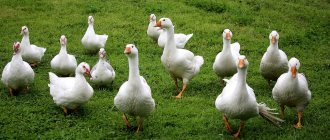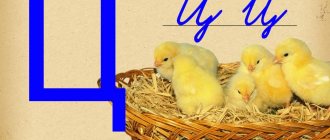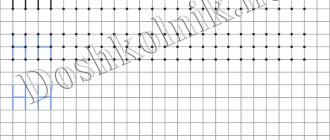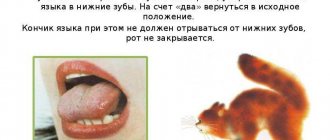Goals and objectives
The main goal of the classes is for the child to master the rules for writing the letter E and the principles of using it in words of different parts of speech, as well as the development of recognition skills for this symbol.
Teaching a child to distinguish the letter E from others, to write it beautifully and legibly, to consciously use it in words, and to pronounce this sound correctly are the main tasks. It is advisable to arouse interest in learning letters with the help of fairy tales, poems, riddles and exciting games for preschoolers.
Learning the alphabet with young children is difficult, but if you conduct lessons on the topic “Letter E” correctly, then problems will no longer arise throughout the entire training.
Errors in understanding
Again, without putting a full stop, we can understand what the person wanted to tell us is not true.
Example:
They write us a letter. Nice, friendly. And there is the sentence “Winter has come. Finally, we will have a break from this dirt on the roads.”
And what do we see here? We are threatened with death in the rude form of “let’s take a break.”
But they wanted to tell us something pleasant, that we would “take a break from the dirt.” That for some time we will not see dirt, and we will feel good about it.
Therefore, it seems to me, one should never neglect placing dots over the letter where E should be written, not E.
Introducing the letter E
It is better to start getting acquainted with the letter E by searching for the letter in the large alphabet. If you succeed the first time (preschoolers already know the previous letters), you can move on. Otherwise, you should help the children with a preparatory, simple poem:
We glue the sticks to the line: One, two, three... and the letter E. The letter E will remind us of the three-pronged comb. (Rein S.)
After listening to such a description, the children will easily find the letter E. It will be good if the children learn this poem by heart in order to better remember and pronounce the desired sound once again. For greater effect, combine repeating the poem with watching an interactive video.
The next stage of learning is to look at a sample of writing a letter. You can write down the desired symbol individually with each child or on the board for the whole group (this is how we teach children independence).
The letter has been studied, children can already distinguish it from others. The next task is to explain to them that E is spelled differently. The simplest and most proven way of explanation is the example of a family, where the large printed E is the father (the head of the family), the large capital E is the mother, and the small “e” is their child.
Distribution in language
In letters, as we have examined, the letter “е” began to be used almost immediately after the meeting of academicians under the leadership of Princess Catherine. But this letter has not yet been allowed into print, although it has become officially recognized since 1784.
The first printed publications with Yo were published in 1795. This was a publication of the works of A.S. Pushkin. Then other Russian writers introduced the letter Yo into their printed publications.
In 1797, the letter E became famous in full. She owes this to the historian Nikolai Karamzin. The Aonida almanac, which was published in a huge edition, managed to replace all the “io” with “e”.
And since the almanac was very popular, many people read it, they immediately noticed this letter and began to use it with pleasure in their writing.
In speech, for some time, the cultural “fucking” remained. It was only in the 20th century that “yocking” began to penetrate.
Task for preschoolers: printed letter E
It is difficult for young children to perceive information only by ear, so it is better to do exercises that also involve eye contact with objects.
Exercise 1
Write E and E in three different colors, for example red, blue, green.
Task 2
Give examples of 3 animals whose names begin with E. Suitable words: raccoon, echidna, unicorn.
Task 3
Name three words starting with E. For example, Christmas tree, ruff, hedgehog.
Task 4
Circle all the E and E in the presented row: A c g v E l e v Sh f m i E y c e f X S F sh k e e k.
Task 5
Name three names that have E in them.
Task 6
Make up five words that contain E.
Task 7
Determine the place of the given sound in the listed words: eve, spruce, bear, hay, foam, hedgehog.
Letters "e" - "e"
The letter e is written at the beginning of the root to convey the vowel e (without a preceding j ):
1. At the beginning of the following native Russian pronominal words and interjections: this (this, this, these), this, this, this, this, this, this; eva, evon, ege, ege ge, hey, ek, eh, ehma, ehe he.
2. At the beginning of words of foreign origin (including proper names), for example: eureka, export, emergency, Hellenic, epic, era, ethics, echo, Etna, Eric (with the letter e , conveying a stressed vowel); eucalyptus, egoism, equator, exam, economy, electricity, element, elite, emotion, energy, epigraph, epidemic, escort, aesthetics, etymology, ether, Everest, Oedipus, Aeschylus (here the letter e conveys an unstressed vowel).
3. After prefixes or components of complex and compound words (both after vowels and consonants). Examples:
a) after vowels: anti-electron, anti-SR, de-escalation, unethical, re-examination, step by step, therefore, re-export; dielectric, movie screen, television screen, megaerg, microelement, polyester, mezzanine, five-story;
b) after consonants: electrodeless, subscreen, pre-examination, razedakiy, save, super-economical, sub-equatorial, super-elite; two-story, three-element, political economy, sanitary and epidemiological station, Mosenergo, Ministry of Economy.
Not at the beginning of the root after vowels (in words of foreign origin) both the letter e and e . Their choice depends on the preceding vowel.
1. After the letters e and i , e is written. List of basic words: Gehenna, register, extravaganza; hygiene, hyena, sharp, diet, realtor, siesta, spaniel, fiesta and words in −ent: applicant, client, ingredient, coefficient, patient, etc. (with the letter e conveying a stressed vowel); fan, leer, player, Jesuit, hierarchy, hieroglyph, myelitis, pielit, pietet, requiem, trier (here the letter e conveys an unstressed vowel).
| Note 1. In the words conveyor and fireworks, ye is written e (see a.1.1.3, paragraph 3). Note 2. In some proper names the letter e is written after and, for example: Marietta, Gliere. |
2. After the letters a, o, y, yu, is written . List of basic words: duel, duet, maestro, minuet, pirouette, poet, poetry, poem, silhouette, figurine (here the letter e conveys the stressed vowel); aloe, airfield (and other words with the initial part aero), firewall, canoe, coefficient, lues, maestoso, muezzin, phaeton, fouette (here the letter e conveys an unstressed vowel). The same in proper names, for example: Puerto Rico, Wales, Hemingway, Maugham, Laertes, Aelita.
| Exceptions: in some proper names the letter e , for example: Marietta, Gliere. Note: Regardless of the preceding letter, words with the second part −hedron are written with e: hexahedron, octahedron, tetrahedron, rhombohedron, trihedron, polyhedron. |
Not at the beginning of the root after consonants, the letter e is written to convey the vowel e and at the same time to indicate the hardness of the preceding consonant in the following cases.
1. In a few common nouns of foreign origin. List of basic words: mayor, master 'teacher, master', plein air, peer, racket, rap, sir; the same in words derived from them, for example: mayor's office, peerage, racketeer. The range of other words (mostly highly specialized) is determined by a spelling dictionary.
2. In many proper names of foreign origin, for example: Bacon, David, Deng Xiaoping, Davis, Rayleigh, Rambo, Salinger, Sam, Sasson, Thatcher, Teffi (personal names and surnames), Maryland, Taipei, Ulan Ude, Yellow River ( geographical names). The letter e is preserved in any words derived from such proper names, as well as when they transform into common nouns, for example: Udensky ulan, Rayleigh (physical unit), sasson (haircut).
In other cases, the letter e .
Moreover, in all native Russian words, the letter e indicates the softness of the preceding consonant, for example: white, wind, word, leg, deed, in the water, underground, trace, laudatory, exchange, wall, census, endure, cut, grow old, spring , reading, ways.
However, in words of foreign origin written with the letter e , the preceding consonant can be pronounced firmly. So, after letters conveying a soft consonant, the letter e is written in the words asbestos, version, ghetto, despot, zebra, comet, lady, pioneer, subscriber, aspect, watercolor, sector, patent, defect and in a number of others. After letters conveying a hard consonant, e is written in the words baby, dandy, delta, model, eczema, cousin, slang, businessman, inertia, phonetics, cappella, rugby, rating, dispensary, setter, cottage, parterre, stand, pace and many others, as well as in indeclinable common nouns, consistently written with the final letter e , for example: meringue, chimpanzee, macrame, summary, pince-nez, tour, coupe, corrugation, puree, dash, cabaret, fricassee, highway, essay, variety show, décolleté , karate, cafe, and in words with a foreign language suffix -nessa (such as poetess, stewardess, baroness); in a number of proper names, for example: Carmen, Nehru, Roerich, Brehm, Dantes, Taylor, Delphi, Saint Gotthard.
Bibliography
|
Tales about the letter
E is the sixth, which means that A, B, C, D and D are already in stock. It is important to use them in small fairy tales, so that children will repeat the material they have studied.
Tale 1
Once upon a time there lived E, she was friends with everyone, helped everyone, if necessary, replaced them in letters. When B fell ill, there was no one to sit on the pipe, good E had to lean against the fence, and they began to look like brothers.
Another friend of ours, who was in trouble, asked to replace him in the word “school”, because he was the first in the list. Kind E came to the rescue here too, lay down on her back and became exactly like Sh.
Following her, T did not have time to fall into place in the word “trampoline.” Then, to help her read and write, E put all her legs and arms in one line and became like T. All together they fell into the right places, and the word formed correctly. So they brought a holiday to the children.
This fairy tale is over, but whoever listened - well done!
Fairy tale 2
Words live in the dictionary, in their own homes - their own sections.
E decided to go visit A. In the morning she set off on a long journey: through mountains, forests, rivers. And in order not to get lost, sister E, E, gave her one of her two balls. And E set off on her difficult journey.
A ball rolls through the forest, E can barely keep up with it, and in the dictionary winter begins, everyone ate in ice sparkles, windows in painted patterns. And the Christmas trees - they seem similar to each other to us. The letter E goes further and further and admires the beauty of the winter forest.
And suddenly someone picks up a dictionary and starts turning the pages. The whole alphabet is in a panic, because if the letters are not in place, the words cannot be found and you can confuse them all: raccoon, and hedgehog, and ruff, and Christmas tree.
We need to save the alphabet, we need to return E to its place. To do this you need to say a special word. Only the hedgehog knew him. Then everyone gathered and unanimously asked: “Hedgehog, say the word.” He agreed, and E returned to her seat just as the last page turned.
History of the letter E
Residents of the city of Ulyanovsk probably never fail to put dots over the letter E if there should be a letter E in this place.
They respect the letter E and even erected a monument to it in the very center of the city.
Until 1783, letters in the Russian alphabet did not exist at all.
But one day in that year, the president of the Russian Academy of Sciences, Princess Ekaterina Dashkova, who was also a friend of the future Empress Catherine the Second, organized a meeting of academicians of literature, among whom were: Derzhavin, Fonvizin and many others.
One of the most enlightened women of that time, the princess asked Derzhavin how to write the word “Christmas tree”. Everyone smiled, considering the princess a joker.
After all, this word was not difficult to write, and in those days it was written like this: “iolka.”
And this was quite common.
But Ekaterina Romanovna did not let up, causing quite natural doubt among those present - there is only one sound, but it is customary to write with two letters, is this logical?
Then she went to the board, removed the first two letters with a rag and wrote “e”.
Although for some time there were different statements about this, but in the end “e” began to be used, first in correspondence with the princess, and then everywhere.
Academicians were the first to write Yo in their letters to the princess. And on November 18, 1784, Yo was officially recognized.
The first word with the innovation was “everything”.
Words starting with the syllable "e"
The syllable “E”, according to its initial sound, belongs to the type - it consists of one vowel, constant sonority
, according to the final sound -
consists of one vowel, constant sonority
, according to the initial and final sound -
open
(is not both covered and closed).
Consisting of 2 syllables:
- ride
- barely
- If
- rider
- riding
- ride
- caustic
- traveled
- drive
- caustic
- drives
- caustic
Consisting of 3 syllables:
- Europe
- Yenisei
- Egypt
- Elena
- hedgehog
- jumble
- Eugene
- echidna
- hedgehogs
- Emelya
- nonsense
- spruce
- Christmas trees
- hedgehog
- hedgehogs
- hedgehog
- heretic
- unity
- cringes
- hedgehog
- hedgehog
- raccoons
- spruce
- elizar
- were driving
- Eroshkin
- was driving
- Christmas tree
- single
- united
- Jewish
- bishop
- Jewish
- went
- units
- raccoon
- cringe
- went
- Jews
- single
- Europe
- Europe
- Egor
- hedgehog
- Yerevan
- snide
- fir trees
- nonsense
- spruce
- driving
- unity
- fidget
- Jews
- Yegoryevsk
- hedgehogs
- Evpatiy
- raccoon
- Egyptians
- Jewish
- raccoon
Consisting of 4 syllables:
- diary
- unit
- once
- blackberry
- the only one
- naturally
- unit
- natural
- European
- spruce
- Evgeniya
- daily
- Euphrosyne
- Egyptian
- the only one
- Eurasia
- hedgehogs
- Epanchinsky
- sledding
- Egyptians
- Evdokia
- European
- Egyptian
- Evgenyevich
- spruce
- the only one
- blackberries
- hedgehogs
- natural
- traveling
- natural
- natural
- single
- natural
- Europeans
- spruce
- European
- blackberries
- eupraxia
- sledding
- the only one
- unit
- European
- daily
- only
- spruce
- Elizarov
- European
- spruce
- united
- hedgehog
- daily
- blackberries
- Eurasian
- Yerevan
- units
- united
- Egozily
- diocese
- Evgenievna
Consisting of 5 syllables:
- Evpatoria
- Elizabeth
- natural
- daily
- the only one
- Catherine
- the only one
- blackberry
- Ekaterinburg
- quarterly
- daily
- Emelyanovich
- monthly
- single
- the only thing
- natural
- natural
- daily
- natural
- daily
- single-handedly
- natural
- weekly
- European
- diaries
- gospel
- annual
- blackberry
- every minute
- Evgenievich
- the only ones
- natural scientists
- unanimous
- European
- European
- single combat
- evangelina
- the only one
- annual
- Egoryevsky
- Evpatoria
- Eliseeva
- monthly
- unity
- Catherine
- naturalness
- unanimously
- European
- European
- martial arts
- Yerevan
- the only ones
- single
- unicorns
- natural
- Eurasian
- autocratic
- evangelical
- only begotten
Consisting of 6 syllables:
- raccoon
- natural science
- at one time
- like-minded person
- natural sciences
- quarterly
- monthly
- Ekaterinburg residents
- one-time
- Ekaterinburg
- martial arts
- weekly
- monthly
- Catherine's
- uniform
- unanimity
- daily
- evangelical
- monthly
Consisting of 7 syllables:
- uniformity
- uniformity
- Yekaterinburg
- one-time
- like-minded people
- uniformity
- natural science
- one-time






